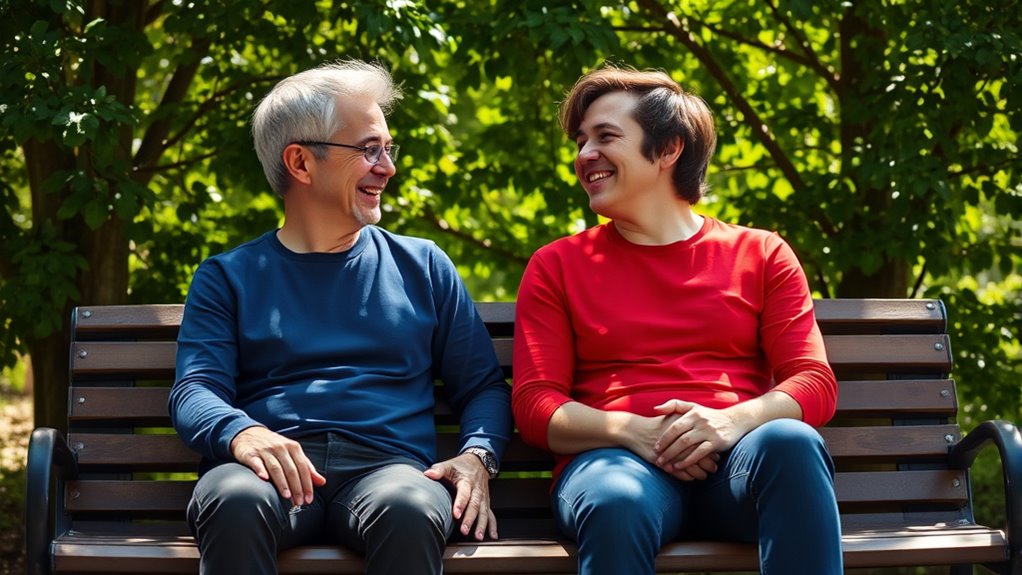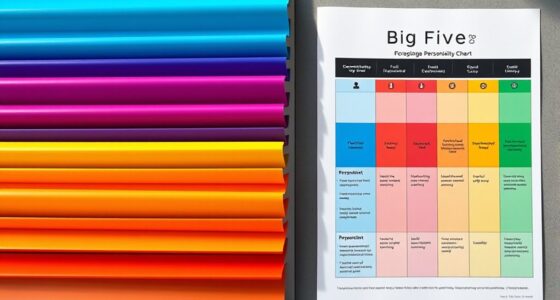Linking your color personality type to relationships helps you understand your emotional needs and communication style. For example, energetic reds seek excitement, while calm blues crave stability, and this insight guides you in choosing compatible partners. Recognizing how traits interact allows you to foster harmony or address potential mismatches. By exploring these color connections, you gain a clearer picture of natural pairings and relationship dynamics, giving you the tools to build stronger, more fulfilling connections.
Key Takeaways
- Color personality types reveal emotional needs and communication styles that influence relationship compatibility.
- Matching traits like energetic reds or calming blues can foster harmonious and complementary partnerships.
- Recognizing personality differences helps reduce conflicts and enhances understanding between partners.
- Awareness of color profiles guides smarter relationship choices and long-term compatibility.
- Harmonious pairings often occur when personality types naturally support each other’s emotional and behavioral traits.

Color personality types can reveal a lot about how you connect with others and what you seek in relationships. When you understand your own color profile, you gain insight into your emotional needs, communication style, and what kind of partner will complement you best. This understanding plays a pivotal role in color compatibility, helping you identify which personality types naturally align and which might require more effort to bridge differences. Personality matching isn’t about finding someone who’s identical to you but about discovering someone whose traits harmonize with your own, creating a balanced and fulfilling connection.
Understanding your color profile reveals how you connect with others and find compatible partners.
For example, if you identify as a bold, energetic red personality, you probably thrive on excitement, passion, and spontaneity. You might be drawn to partners who share that same lively spirit, making your relationship vibrant and dynamic. Conversely, a calm, nurturing blue personality seeks stability, trust, and emotional depth. You’ll likely find compatibility with someone who appreciates serenity and values meaningful conversations. Recognizing these tendencies helps you avoid mismatches that could lead to frustration or misunderstandings down the line.
Color matching isn’t just about choosing the same hues; it’s about understanding how different personality types interact. For instance, fiery reds and warm yellows might naturally ignite each other’s enthusiasm, creating a passionate, lively bond. On the other hand, cooler greens and blues tend to foster harmony and deep emotional connection, which is ideal if you’re looking for a more tranquil, supportive relationship. By paying attention to these subtle cues, you can better navigate potential partnerships, knowing which color personality combinations are more likely to lead to long-term compatibility. Additionally, understanding your own color personality can help you choose partners who complement your emotional needs and communication style more effectively.
Knowing your own color personality helps you communicate your needs clearly and recognize what you value most. If you’re a vibrant orange, you may crave adventure and social activity, so finding a partner who shares or appreciates that energy can lead to a more satisfying relationship. On the flip side, if you’re more introspective and reserved, matching with someone who respects your space and values deep conversations will foster mutual understanding. When you focus on personality matching through the lens of color compatibility, you’re more equipped to choose partners who naturally complement your traits, reducing conflicts and increasing your chances for lasting happiness.
Ultimately, understanding how color personality types influence relationships empowers you to make smarter choices. It’s not about limiting yourself to specific types but about recognizing the traits that create harmony and fulfillment. When you pay attention to personality matching and color compatibility, you turn relationship dynamics into opportunities for growth, connection, and genuine understanding. This awareness guides you toward partners who resonate with your core, making your journey toward love more intentional and rewarding. Recognizing the role of color personality types in relationships can significantly enhance your connection and compatibility with others.
Frequently Asked Questions
How Do Color Personality Types Influence Communication Styles?
Color-based communication shapes how you express your personality. For example, red personalities tend to be direct and assertive, while blue types prefer thoughtful, detailed conversations. Your color influences how openly you share ideas and respond to others. Recognizing these differences helps you adapt your communication style, making interactions more effective. By understanding your personality expression and others’, you foster better connections and reduce misunderstandings in every conversation.
Can Color Personality Types Change Over Time?
Sure, your color personality can shift like a chameleon at a rave. With personality adaptability and emotional resilience, you might discover new hues in your palette over time. Life’s experiences challenge your core, nudging your colors to evolve. So, don’t fret—your traits aren’t set in stone. Embrace change, grow, and watch as your vibrant personality transforms, proving you’re more Picasso than a fixed color swatch.
Are Certain Color Personalities More Compatible Than Others?
Yes, some color personalities tend to be more compatible than others due to personality matching. For example, a calm blue may complement a lively yellow, creating balance. However, color compatibility isn’t the only factor—understanding each other’s strengths and communication styles matters most. You should focus on how your personalities align, rather than just color types, to build a healthy, harmonious relationship.
How Do Cultural Differences Affect Color Personality Perceptions?
Cultural differences profoundly influence how you perceive color personality types through cultural symbolism and cross-cultural perceptions. In some cultures, red symbolizes passion and energy, while in others, it signifies luck or danger. These varying meanings shape your understanding of personality traits associated with colors, affecting how you interpret and relate to others. Recognizing these cultural nuances helps you navigate diverse perspectives, fostering better relationships across different backgrounds.
What Practical Steps Can Improve Relationships Based on Color Types?
Think of your relationships as a vibrant tapestry, woven with different color threads. To improve it, focus on color compatibility—understanding each other’s personality hues. Practice emotional intelligence by listening actively and respecting differing colors’ needs. You can also celebrate shared colors or learn to adapt when colors clash. These practical steps help you create harmony, turning your connections into a masterpiece of understanding and genuine affection.
Conclusion
As you explore your color personality, imagine a vibrant palette shaping your connections—bold reds igniting passion, calming blues fostering trust, or cheerful yellows sparking joy. Recognize how these hues influence your relationships, painting your world with unique shades of understanding and connection. Embrace your colors, and watch as your relationships blossom like a garden bursting with life and color, creating a vivid masterpiece that reflects your true self.
Felicity, our Author, pens in-depth articles and guides that delve into the heart of personal discovery. Her narrative-driven approach weaves together theory, practice, and personal anecdotes, making the journey of self-exploration both relatable and inspiring. Felicity’s contributions help illuminate the path for those seeking a deeper understanding of themselves and their relationships.









